yeovil people
William Porter
Printer, Bookseller and Bank Actuary
William Porter was born in Somerset around 1800 but nothing is known of his early life. William married Eliza Poole, daughter of James and Elizabeth Poole of Kentish Town, Middlesex. They were certainly living in Hendford, Yeovil, by 1826 when their first child, daughter Marianne, was born on 2 November 1826 at Hendford. She was baptised at the Baptist Chapel in South Street. William and Eliza were to have at least five other children; Joseph (b1829), Emily (b1831), William (b1832), Julia (b1835) and Victoria Eliza (b1837).
Initially William Porter was in partnership with John Totterdell Boucher as booksellers, stationers, printers and bookbinders of Yeovil. However the partnership was dissolved in November 1826 and Boucher moved to Burnham, Somerset. William was listed in the Jury Service list of 1827 as being a Stationer and Printer of Hendford and he was regularly listed in the Churchwardens' Accounts for his services as a Printer, Bookseller and Stationer from 1829 until 1834.
The beginnings of the Deposit Bank in High Street were outlined by Daniel Vickery in 1856 as follows - "A safe depository for the poor man's savings was long the object of public solicitude; and at last, the Government taking the matter in hand, brought a bill, or bills, before Parliament, which established, under very strict regulations, what are now called Savings' Banks, all over the country. This kind of bank was first established in Yeovil about the 11th March 1818, Mr Boucher, bookseller, being appointed first Actuary. His business was carried on in the premises lately occupied by Mr Singleton, adjoining the Choughs Hotel. Mr Porter, bookseller, afterwards became Actuary, who removed his shop and the bank to the premises now occupied by Mr Custard, bookseller. On Mr Porter's removal, Mr Custard was appointed to the office. Previous to this, the trustees, in the year 1838, erected the present handsome building, on premises then occupied by Mr Hull, glover, at a cost of about £1,000."
(An Actuary is a person who compiles and analyses statistics and uses them to calculate insurance risks and premiums.)
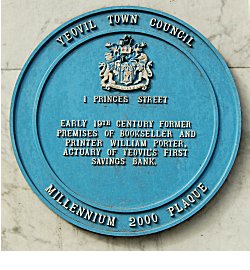 In
1827 William
Porter, printer
of Yeovil, was
on the Jury List
as a stationer
in Hendford next
to the Three
Choughs Hotel.
By 1829
William left his premises
next to the
Three Choughs
when the
building was
sold
(see Gallery).
He moved further
along Hendford (as
this part of
Princes Street
was then known)
on the corner of
what was known
as
Porter's Lane
(named after
William and later
to be widened
and to become
Westminster
Street in the
1930's) to the
building which
is today's
1&3 Princes
Street. This
building became
the second home
of the Deposit
Bank.
In
1827 William
Porter, printer
of Yeovil, was
on the Jury List
as a stationer
in Hendford next
to the Three
Choughs Hotel.
By 1829
William left his premises
next to the
Three Choughs
when the
building was
sold
(see Gallery).
He moved further
along Hendford (as
this part of
Princes Street
was then known)
on the corner of
what was known
as
Porter's Lane
(named after
William and later
to be widened
and to become
Westminster
Street in the
1930's) to the
building which
is today's
1&3 Princes
Street. This
building became
the second home
of the Deposit
Bank.
In the 1830s Yeovil had a branch of the Mendicity Society, whose headquarters were in London. "The society gives meals and money, supplies mill and other work to applicants, investigates begging-letter cases, and apprehends vagrants and impostors. Each meal consists of ten ounces of bread, and one pint of good soup, or a quarter of a pound of cheese. The affairs of the Society are administered by a Board of forty-eight managers. The Mendicity Society's tickets, given to a street beggar, will procure for him, if really necessitous, food and work". A mendicant (from the Latin mendicans, meaning "begging") is one who practices mendicancy (begging) and relies chiefly or exclusively on charitable donations to survive. The Manager of the Yeovil branch of the Mendicity Society was William Porter who became embroiled in the manslaughter case against James Beare, watch-man of Yeovil, in 1838, when a mendicant in search of work as a collar-maker applied to William in his role as Manager of the Mendicity Society for relief, at about 10 o'clock on the night in question. The rules of the society did not permit the granting of relief after 9 o'clock at night nor to individuals labouring under intoxication. William refused relief and the beggar was locked up in the watch-house, where he died. For full details of the case - see here.
During the 1830s William was also a member of the Vestry and the Board of Guardians who oversaw the running of the Yeovil Union, including the management of the workhouse - at this time the 'Old Workhouse' in Vicarage Street was on the site currently occupied by the Methodist church. He was also involved with local charities and in 1835 he was a trustee of the newly-formed Female Guardian Friendly Society along with solicitor James Tally Vining and draper Benjamin Ryall.
Pigot's Directory of 1830 listed William as 'Bookseller, Stationer, Printer, etc. of Hendford' and, in a separate listing, as an Agent for the Guardian Fire Insurance Company. In 1835 a handbill was noted as printed by 'Porter's General Printing Office'.
Henry Marsh Custard originally ran a printing business at Parkstone, Dorset but ceased printing there at the end of December 1838 and moved to Yeovil. By 1839 William and Henry were in partnership and the announcement of their partnership is shown in the Gallery below. Porter & Custard, printers and stationers were recorded in the Churchwardens' Accounts of 1839 and a handbill was noted as printed by 'Porter & Custard, Printers'. The Somerset Gazette Directory of 1840 listed Porter & Custard no less than four times; as Booksellers & Stationers, as Printers, as Agents for the Guardian Fire & Life Insurance Company and finally as Agents for the York & London Fire & Life Insurance Company. They were also agents for the Somerset County Gazette. Porter & Custard had a library on the premises as well as a news room. A series of lectures were held in the latter during 1840.
In the 1841 census William and Eliza were listed living at Hendford with their five children and two servants. This was not, however, today's 1&3 Princes Street where Henry Custard and his family lived over the premises, but was closer to Church Street. William gave his occupation as Actuary. The 1841-2 Register of Electors listed William Porter of Hendford as owning a freehold house and premises occupied by Henry Marsh Custard.
In August 1841 William Porter and Henry Custard announced that their partnership was henceforth dissolved.
Despite extensive searches, no further records have been found concerning William Porter or any of his family.

William Porter's signature against the Vestry minutes of 29 December 1831.
gallery
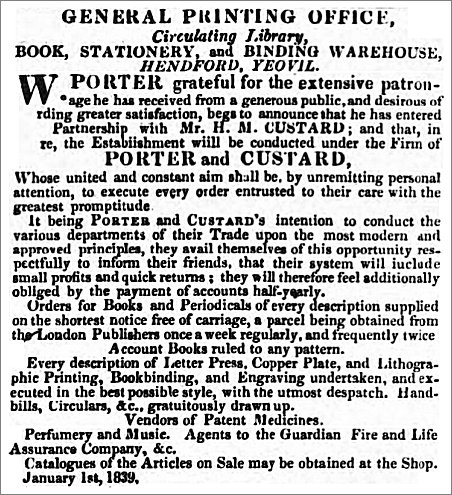
A notice placed in the 10 January 1839 edition of the Somersetshire Gazette announcing the partnership of Porter & Custard. It is interesting to note (at the bottom of the advertisement) that a sideline was dealing in 'Patent Medicines, Perfumery and Music'.
Below are two hand-tinted stone lithographs by Henry Burn (1807-1884). There are not many known stone lithographs by Henry Burn because he left for Australia in 1852. These two lithographs, both of 1839, are amongst the earliest known works by Burn whose other known works date from the 1840s. Both lithograph prints were published by William Porter and Henry Marsh Custard in January 1839 (and consequently among the first items published by Porter & Custard) and printed by Charles Joseph Hullmandel (1789-1850) of London, where he maintained a lithographic establishment on Great Marlborough Street from about 1819 until his death.
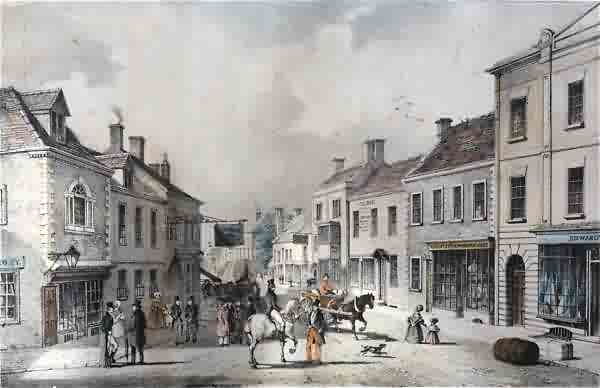
From my
collection
This subtly-coloured, and remarkably accurate (when compared with early photographs), lithograph of 1839, entitled 'Market Place - Yeovil', looks down High Street from its junction with Hendford / Princes Street. On the left the Mermaid with its familiar archway and large overhanging sign is clearly seen. On the opposite side of the road, just right of centre, the white three storey building with the two-storey projecting bay is the Kings Head Inn. It is likely that the two storey building next to the Kings Head Inn is the building that held the former George Inn.
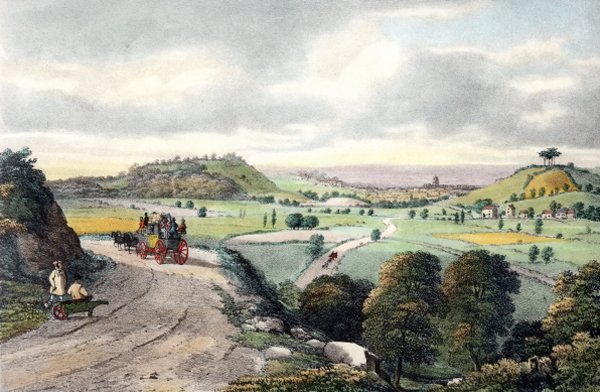
'View of Yeovil from Babylon Hill' in a stone lithograph also by Henry Burn (c1807-1884) and again published by William Porter and Henry Marsh Custard in 1839. With Summerhouse Hill at left, with Penn Hill behind it, surmounted by Penn House, and Wyndham Hill at right. The buildings at Pen Mill are seen at the base of the latter, with the tower of St John's church above and to the left. At centre, a horse-drawn cart is seen on the Sherborne Road before it was re-aligned
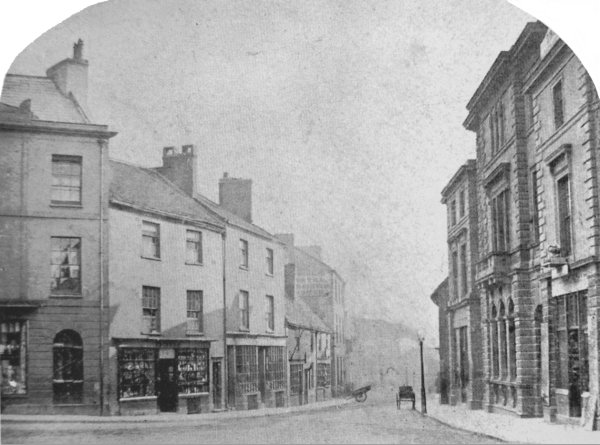
This photograph, one half of a stereoscopic pair, was taken around 1870 and looks down Hendford with High Street and the shop of Lindsay Denner at extreme left. The impressive building at right is Stuckey's Bank, facing High Street, and demolished in 1918. At centre, the three-storey building in the distance is the Three Choughs Hotel and the two-storey building to its immediate left was Boucher & Porter's premises which also served as the first premises of Yeovil's first Savings Bank of which John Totterdell Boucher was its first Actuary and William Porter became its second Actuary after the departure of Boucher to Burnham.
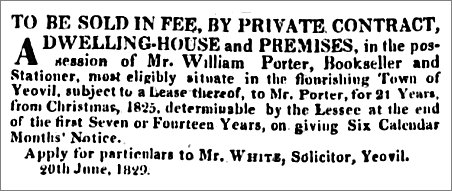
A notice placed in the Taunton Courier (and elsewhere) in June 1829 advertising the sale of William Porter's premises.
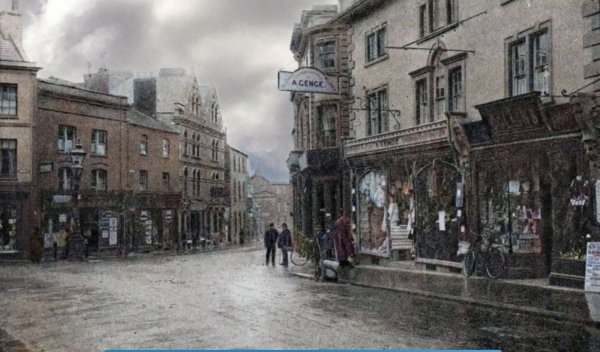
From my
collection.
This
colourised image
features in my
book 'Yeovil
- The Postcard
Collection'.
This postcard of the northern end of Hendford, postally unused, I'd guess dates to about 1895. At extreme left is just seen the edge of Lindsay Denner's shop and next to it are the remaining shops before he took them over. The two men at centre are standing outside Stuckey's Bank (demolished before 1918) and between the bank building and Genge's shop is the narrow entrance to Porter's Lane (later widened to become today's Westminster Street). In fact the whole of the building at right had been the bookshop of William Porter and the second premises of the Deposit Bank.
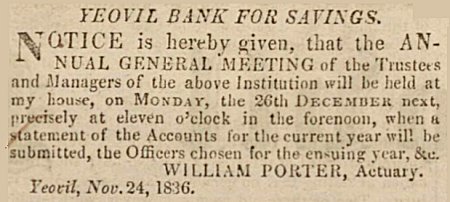
Notice place by William Porter as Actuary for the AGM of the Yeovil Bank for Savings in the Western Flying Post's edition of 5 December 1836. The meeting was to be held at 'my house' the location of which, presumably, everyone knew. William would place similar notices annually. He was Actuary from 1827 (the departure of his partner Boucher, the first Actuary) until at least 1841.

A notice placed in the 10 January 1839 edition of the Somersetshire Gazette announcing the partnership of Porter & Custard. It is interesting to note (at the bottom of the advertisement) that a sideline was dealing in 'Patent Medicines, Perfumery and Music'.

.... and almost immediately they began hiring staff - in this case an apprentice - as advertised in the Dorset County Chronicle's edition of 7 March 1839.
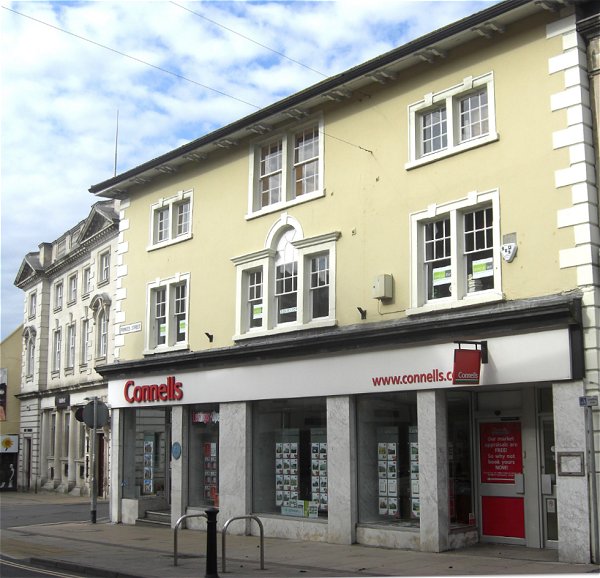
William Porter's premises (note the Millennium Blue Plaque) - the Princes Street elevation of this lovely building with the usual unsympathetic twentieth century ground floor shop fronts and the inappropriate removal of lower glazing bars to the first floor fenestration. Photographed in 2013.